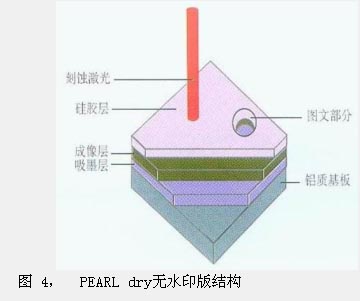Waterless offset uses a specific ink. It requires a higher viscosity to ensure good repellency of non-textured silicone rubber layers, that is, high viscosity inks can ensure that the silicone rubber layer does not stick ink, no dirty plate appears (blank part without ink), at the same time The graphic part of the printing plate has a good affinity, and can match the type and material of the blanket to ensure the smooth transfer and transfer of the ink. It also requires that the ink does not contain coarse particles to prevent scratches on the protective film on the surface of the plate, while avoiding the friction of the particles to generate heat and reduce the viscosity of the ink.
(4) Temperature Control System
For high-viscosity waterless offset inks, the important factor affecting the viscosity of the ink is temperature. Small changes in temperature can cause the ink viscosity to change greatly. For example: The viscosity of the ink at 25°C is 100-150 poise, but at 40°C the viscosity drops sharply to 30-40 poise. In the continuous printing process, due to mechanical friction (between the rollers, between the roller and the plate, and between the plate and the blanket) factors such as the plate surface temperature will increase, because of the viscosity of water-free ink Large, friction between the waterless ink and the ink roller will also increase the temperature, resulting in a drop in the viscosity of the printing ink.
It is because of the high requirements for the viscosity of the ink that a temperature control system has to be used on the printing press to precisely control the temperature of the ink. Air-cooled and water-cooled methods are commonly used in CD offset printing machines. Whichever method is used, the temperature is controlled at a constant value to maintain the viscosity of the ink without water.
Air-cooling method: the constant temperature cold air is blown to the surface of the ink roller and plate cylinder to reduce the temperature of the plate surface, maintain the ink temperature, and maintain the viscosity of the ink. Such as the German KAMMANN offset press.
Water-cooling method: mainly in the lithography of the offset printing press, it is provided with enough cooling water to control the temperature. Such as Taiwan lithographic offset press.
Although different brands of waterless offset inks have different suitable temperatures, it is necessary to control the temperature difference between the platen and the roller to maintain it within the ±15°C range. Some inks have a temperature tolerance of ±0.8°C, while others Has a temperature tolerance of ±1.5°C. If the temperature is too high, the non-graphical part of the silicone resin will be stained with ink and a dirty plate will appear. If the temperature is too low, the ink will be transferred poorly, and the full version will not occur with white spots. Therefore, the balance control technology for the temperature-free offset printing ink is a key technology for the horizontal offset printing press.
In the actual printing production manipulation, the operator should adjust the temperature accordingly according to the selected ink and printing speed.
3.2 Presstek System
The Presstek PEARL dry waterless version consists of two parts: a waterless version and a waterless ink similar to Toray.
Presstek claims that the temperature control system on the press is an option. PEARL dry no watermark version with a maximum capacity of 50,000 impressions. If the print volume is less than 10,000 prints, there is no effect on the temperature on the press. Only the long-run version requires a temperature control system. PEARL dry is not watermarked, but it can also be recycled. The maximum size is four open.
The PEARL dry waterless version consists of four layers: an ink-repellent silicone rubber layer, a light-absorbing imaging layer, an ink-receiving layer, an aluminum base or a polyester base layer. PEARL dry without watermark imaging, no need for film, no exposure, no processing. Its imaging uses mainly an ablation technique. Use an infrared laser diode to ablate the silicone rubber coating on the plate to expose the underlying ink-receptive layer. During imaging, the laser rapidly heats the imaging layer to record images. The imaging layer is evaporated and the upper silicone rubber coating is stripped from the plate to form a graphic. After the plates are imaged, they must be cleaned and printed on the plate cylinder.
The system can be imaged using Presstek's direct platemaker.

(to be continued)
Paper Bag,Paper Gift Bag,Shopping Bag
Paper Gift Box Co., Ltd. , http://www.tbl-packing.com